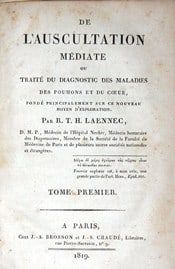Changing Medicine in a Heartbeat
Réné Laënnec (1781-1826). Traité de l’Auscultation Médiate , Paris, 1819.
Médiate , Paris, 1819.
The stethoscope is so familiar an object, it is somewhat surprising that it did not arrive on the scene until 1816. In fact, if it had not been for a fear of breaching 19th century etiquette, we might have had to wait even longer for its appearance. While the noises of the chest had long been linked to certain conditions, it was not until Réné Laënnec, a Paris physician, was confronted with a patient who, “…owing to her stoutness little information could be gathered by application of the hand and percussion. The patient’s age and sex did not permit me to resort to the kind of examination I have just described (i.e., direct application of the ear to the chest.)”. Recollecting that children often listen to noises through hollow logs, Leannec rolled up several sheets of paper to form a tube and found to his delight that he could hear better with his new invention than he could with the ear alone. After a good deal of experimenting, Leannec produced a wooden instrument with which he learned to discern the significance of the various sounds which he described in great detail. His descriptions were so keen that they retain their accuracy and authority to the present day. Laënnec published his findings in Traité de l’Auscultation Médiate in 1819 in two volumes. The copy in the John Martin Rare Book room is particularly well preserved and includes the many folding plates illustrating Laennec’s invention that quickly became the fundamental diagnostic tool we recognize today.
Click here to view larger images of Traité de l’Auscultation Médiate.